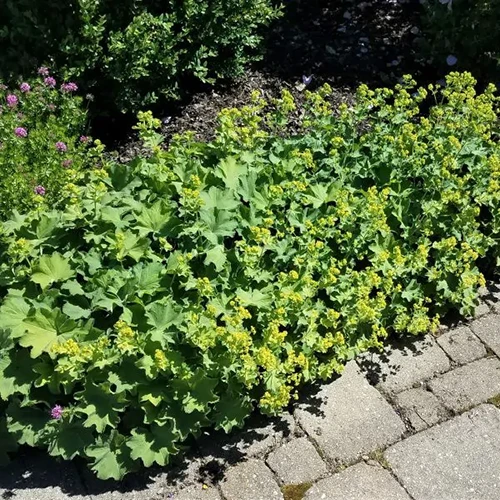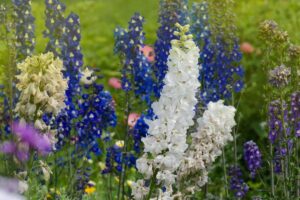Alchemilla mollis
It’s leafy, it’s vigorous, and it’s chartreuse. Alchemilla mollis, aka lady’s mantle, aka “that dang leafy thing that grows fast,” is a familiar plant in many gardens.

We link to vendors to help you find relevant products. If you buy from one of our links, we may earn a commission.
You’ve probably seen it before, whether you realized it or not, and today we’re going to cover all you need to know about this tenacious perennial to grow it at home.
Lady’s mantle is a plant requiring very little care or attention, so your notes here will be short. You have permission to doodle instead, go ahead, it’s okay. Let’s dive in, shall we?
What You’ll Learn
What Is Lady’s Mantle?
Regular readers who recognize my name won’t be surprised to see that I’ve written about lady’s mantle.
I have a strong preference for tough and independent plants. It might actually be an obsession, but we’ll stick with “strong preference.”

You’ll recognize lady’s mantle by its palmate, scalloped leaves, complete with serrated edges.
It’s a simple and understated chartreuse and will develop a lovely spray of yellowish-green flowers in the late spring and early summer.
With vigorous cutbacks, it’s possible to get a second display in the fall.
Many types of Alchemilla exist and all have similar care requirements.
The focus of this article is on Alchemilla mollis, the most commonly encountered species in the garden. When people say “lady’s mantle,” they are almost always referring to A. mollis.
Cultivation and History
A. mollis is a low-growing, herbaceous perennial that can happily grow in USDA Zones 3 through 8.
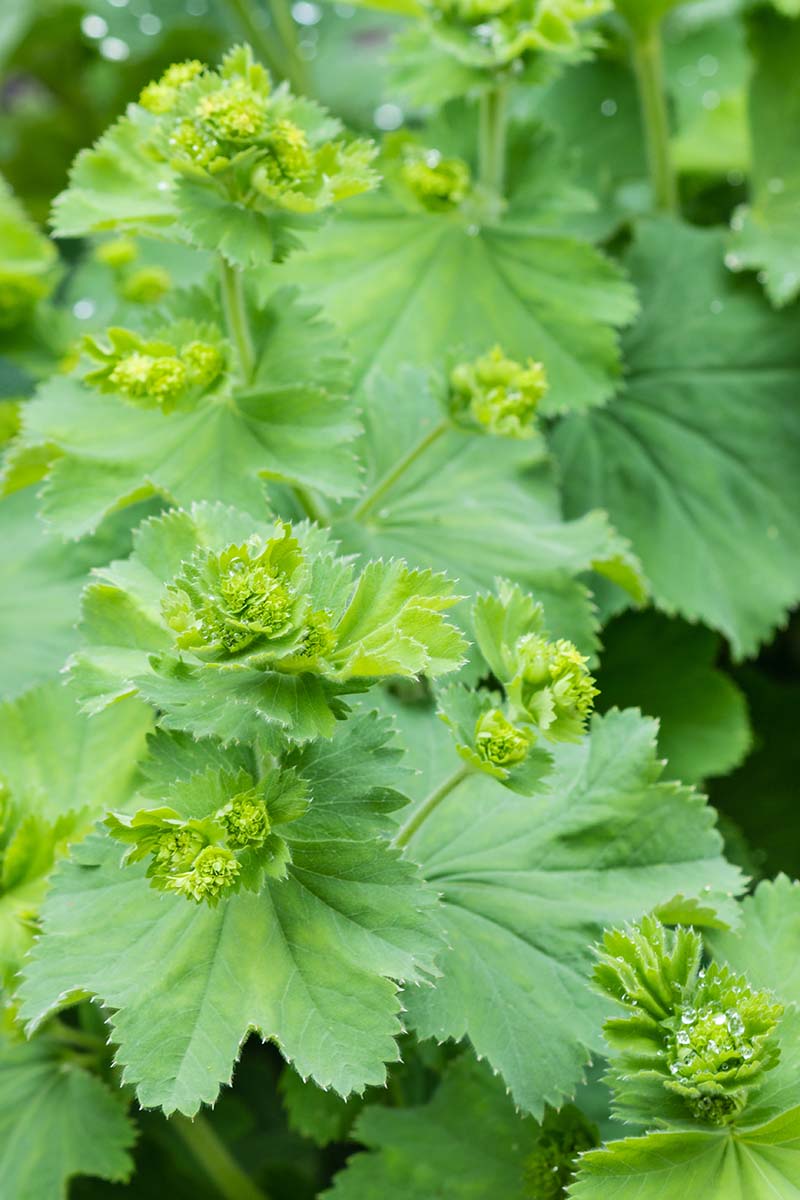
Calling it “hardy” is an understatement. Gardeners possessing experience with lady’s mantle know it’s closer to super hardy, and can even be considered invasive if it’s allowed to reproduce at will.
In fact, in Oregon and Alaska, lady’s mantle is classified as an invasive species.
It’s not native to the United States. Its origins are in Turkey and the Carpathian Mountains. That’s right, lady’s mantle shares its homeland with Dracula.
In ancient times, A.mollis was used to dye wool and other fabrics green, and also as a natural remedy to deal with digestive issues.
Like many perennials, it migrated with people from its homeland and has since taken its place as a garden staple cultivated worldwide.
Lady’s Mantle Plant Propagation
A. mollis is very, very eager to establish itself. In fact, I’d say you’ll spend more effort stopping it from spreading than trying to increase and expand what you’ve got. It grows readily from seed, but slowly via rhizomes.
In other words, you’ll be scrapping baby mantles far more often than you’ll need to divide your plants.
An important note to make is that it can take as long as two years for your lady’s mantle to flower when grown from seed, so don’t be worried if yours seems slow to mature.
From Seed
Prepare to meet what I’d like to refer to as the perennial version of the radish.
Lady’s mantle is extremely reliable when grown from seed. It’s so easy to grow, you can simply spread the seeds directly in your garden beds two or three weeks before your last frost date.
They’ll pop up before you know it and take their fair stake of the garden, and you’ll have about as many plants in the bed as seeds you tossed down.
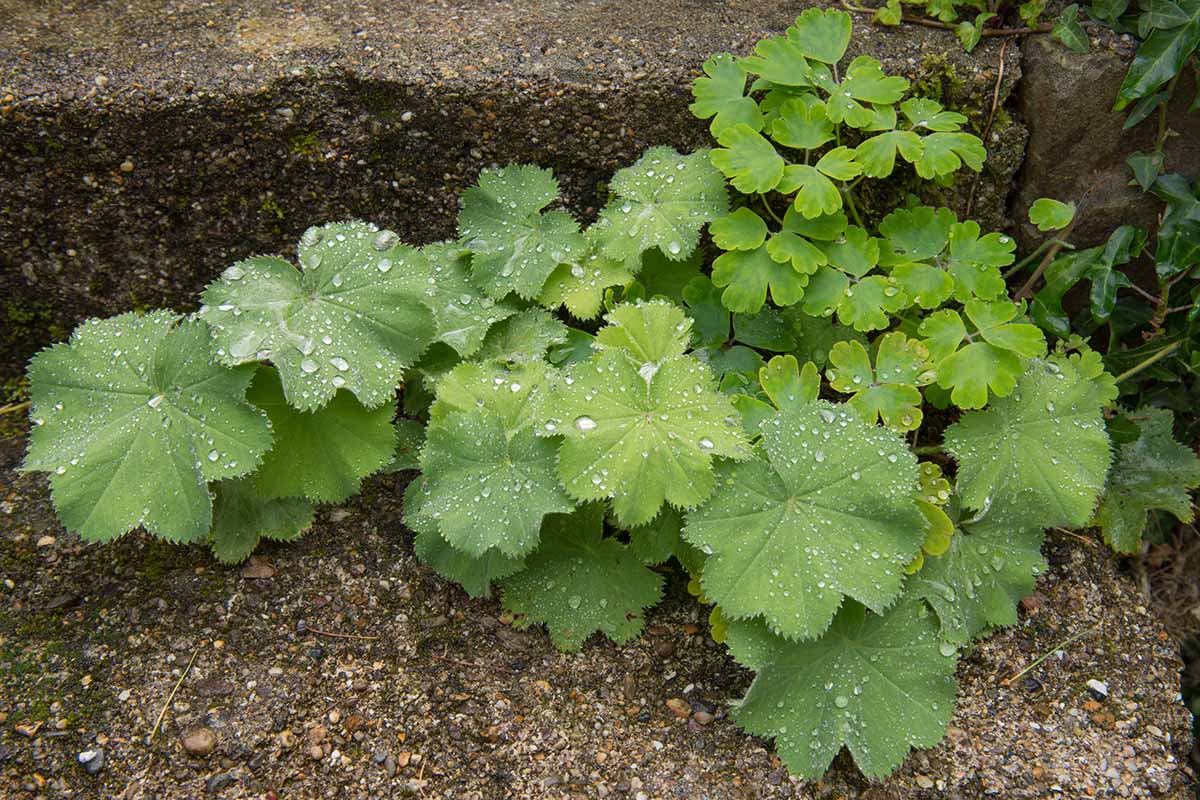
It’s far easier and more reliable to sow your seeds directly in the ground. But if for some reason you’ve got your heart set on growing lady’s mantle in a seed tray to transplant, you can do that too.
Start your A.mollis seeds indoors eight to 10 weeks before the last frost date.
This leafy grower needs about three weeks of cold stratification in the refrigerator prior to sowing.
After they have been cold stratified, sow in a seed-starting medium under a light coating of soil – about a quarter-inch is sufficient.
Ensure they’re receiving bright, indirect light. Keep the soil evenly moist, but not waterlogged.
Once the seedlings develop a second set of true leaves, you can start graduating your babies from their sheltered home indoors to the big, wide outdoor world.
When the temperature is above freezing you can keep the seedlings outdoors in a sheltered location for an hour or two at a time – up against your home or on a covered porch, anywhere they get to experience a bit of sun, wind, and cool air.
Slowly extend the time they’re outside by an hour or two each day. After a week or so, your seedlings can stay outside in their semi-sheltered environment for good.
After the last frost date you can plant your baby lady’s mantles in the garden where you want them to grow. Give them a nice drink of water and a little dash of compost and you’ll see them taking off before you know it.
From Rhizome Divisions
Lady’s mantle is a good candidate for root division. In fact, it benefits from this type of care every three or four years.
It’s best to divide in the late summer, right before the start of fall, but you can also divide during the spring.
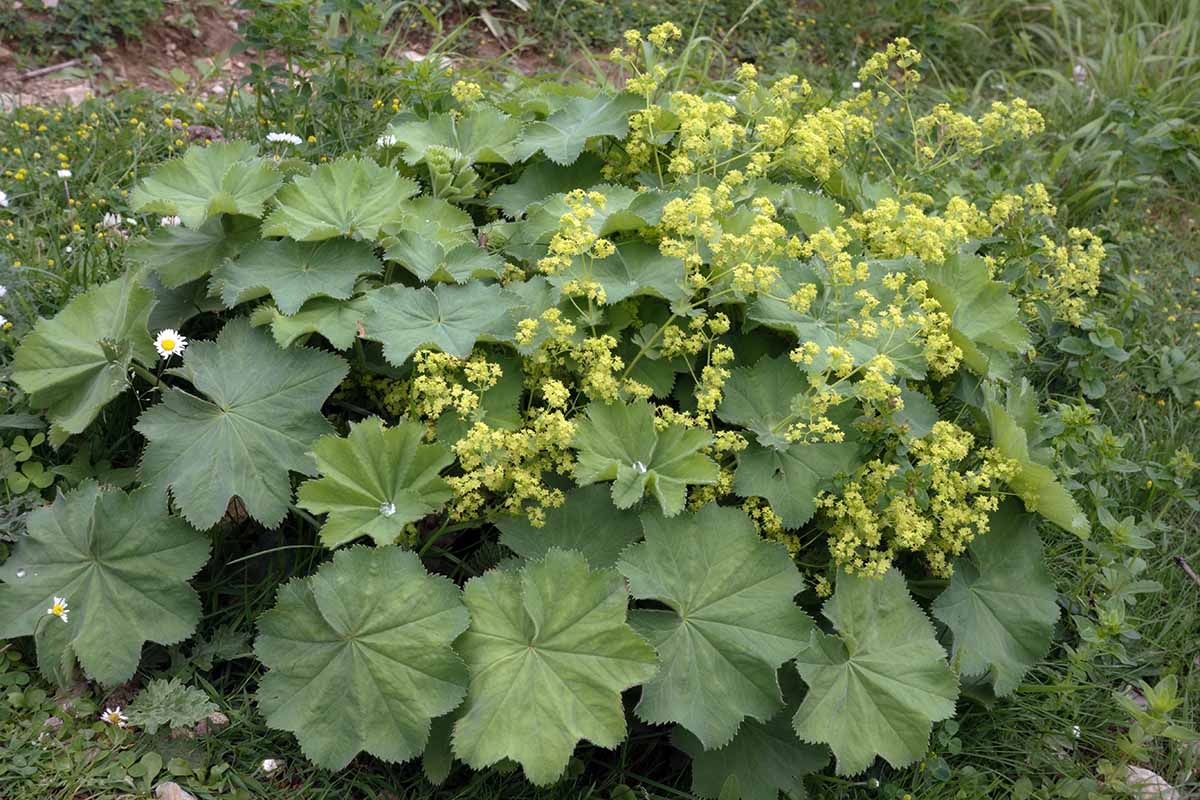
Dig up your established plants. Using a sharp knife or spade, chop the rhizome into two or three pieces.
The exact number of divisions you’ll get depends on the size and strength of your plant. Make sure each piece you divide has healthy leaves on it so it will survive the process.
The rhizomes should still have some roots attached as well.
Plant your soon-to-be-strong Alchemilla so the remaining roots are firmly pressed into the soil.
These kinds of plants, when divided, are extremely top heavy and will easily flop over if the roots aren’t packed firmly into the soil.
I don’t think you need to worry about supporting the plant at all. Give it a drink of water when transplanting the divisions and water them regularly for a couple of days after.
Before you know it, your lady’s mantle will be standing tall and strong.
How to Grow Lady’s Mantle
Lady’s mantle demands very little. It’s not an exaggeration to say it’s nearly a weed!
Let’s look at the specifics.
Soil and Climate Needs
A. mollis is at its best when it’s getting at least six hours of sunshine every day. It benefits from shade in the hot afternoons when sunshine is at its strongest.
Lady’s mantle is excellent in woodland gardens that are soaked in sunshine until the early afternoon hours.
The farther south you are and the hotter your summers get, the more afternoon shade you want to provide.
As far as soil requirements go, this plant is adaptable.
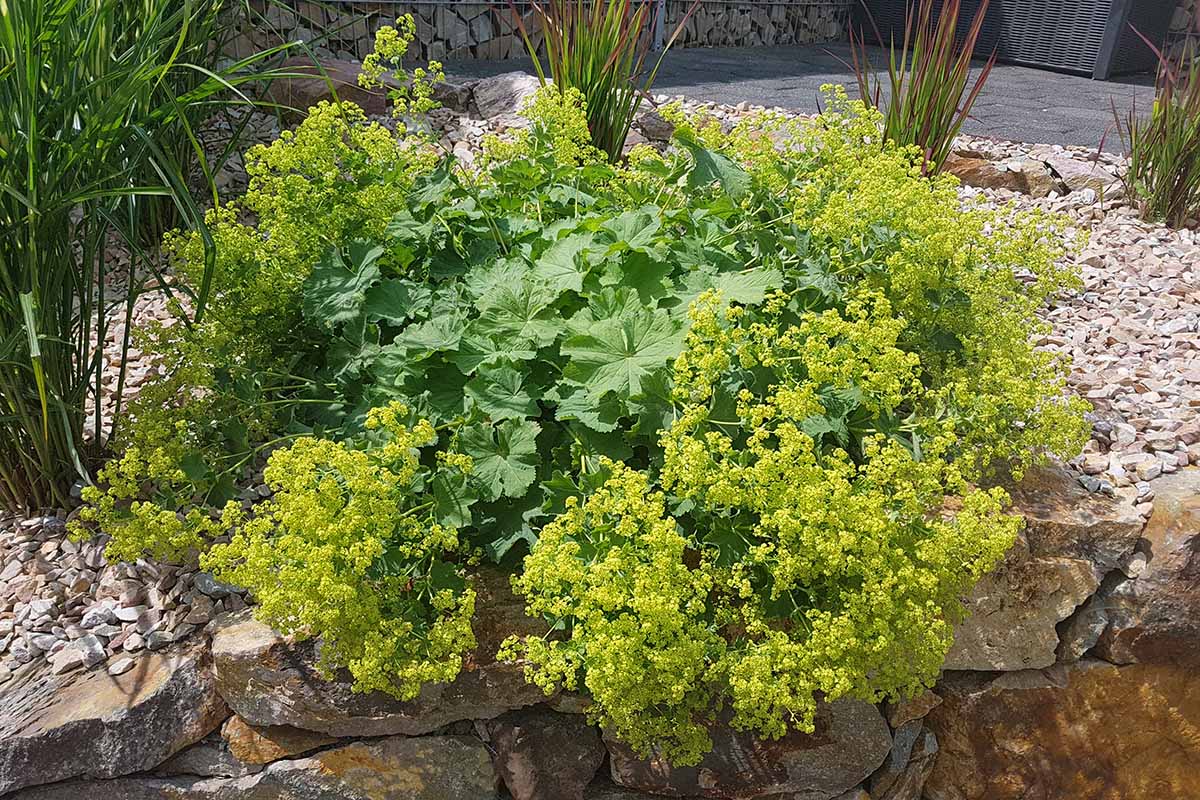
I’ve seen it grow in rich and loamy soil so friable you’d write home about it, and also in far more compact and dry conditions.
As long as it’s receiving the right amount of sunlight and an average amount of water every week, lady’s mantle will adapt and survive.
For perfect conditions, we are looking for a soil that’s in the 5.5 to 7.5 pH range and drains quickly.
This makes Alchemilla a perfect companion for other low-maintenance favorites like hens ‘n’ chicks, heuchera, herbs like thyme and lavender, and other garden staples that favor generally poor soil conditions.
Fertilizing
Simply put, don’t fertilize your lady’s mantle.
It grows quickly, readily, and almost aggressively all on its own and doesn’t require additional fuel to do so.
But if you’re like my wife and look forward to fertilizing everything in the garden, you can provide an annual application of compost or a simple granular fertilizer.
We live in an Osmocote household so it’s pretty much the only slow-release fertilizer I use.

It’s been around forever, it’s affordable, and it works. You can find one-pound packages on Amazon.
I will also use Espoma Plant-Tone every chance I get. Why? I think it just smells good, for starters…

Find it on Amazon in two-packs of four-pound bags.
Hey, Calvin Klein, are you reading this? Give me a Plant-Tone-scented cologne and you’ve got a customer for life.
I’ve used both with Alchemilla and have had almost identical results.
Water
An average amount of water – an inch of rain a week – is all that’s required to keep your lady’s mantle happy and healthy.
It can handle drought better than other leafy plants, but like anything else that’s green and leafy, it needs a drink regularly to be happy and do its thing.
Growing Tips
- Give it full sun but provide shade at the hottest times of the day in summer.
- Many soil qualities are tolerated, but it prefers a sandy and fast-draining location.
- Don’t fertilize unless you feel utterly compelled to!
Maintenance
I’ve worked with lady’s mantle in gardens that are meticulously maintained, and in others where pruning is a four-letter word.
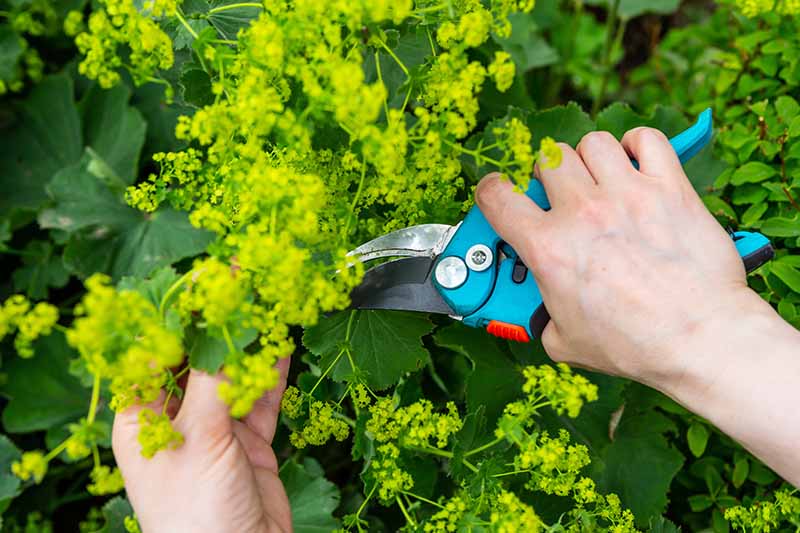
In my experience, A. mollis is at its best with three or four aggressive bouts of maintenance a year. Outside of these couple of tasks, you’re free!
In the Spring
Springtime cleanups are a favorite activity and it’s because of plants like A. mollis that it’s so enjoyable.
Clean up any crispy foliage and free the crown of debris, paying closest attention to anything that feels slimy and limp.
You know the feeling of that stuff. It’s like you grabbed a handful of stringy seaweed when the water’s too cold to swim in.
It conforms to your skin and you wash your hands a second time after handling it.
Dealing with this kind of plant material is why I both hate and love garden gloves.
In the Summer
It’s the first few hot days of the year. You’ve got your lemonade, or your cold-but-rapidly-warming beer, or your mojito, and you wanna do something in the garden.
Perfect, because your lady’s mantle needs to be deadheaded ASAP!
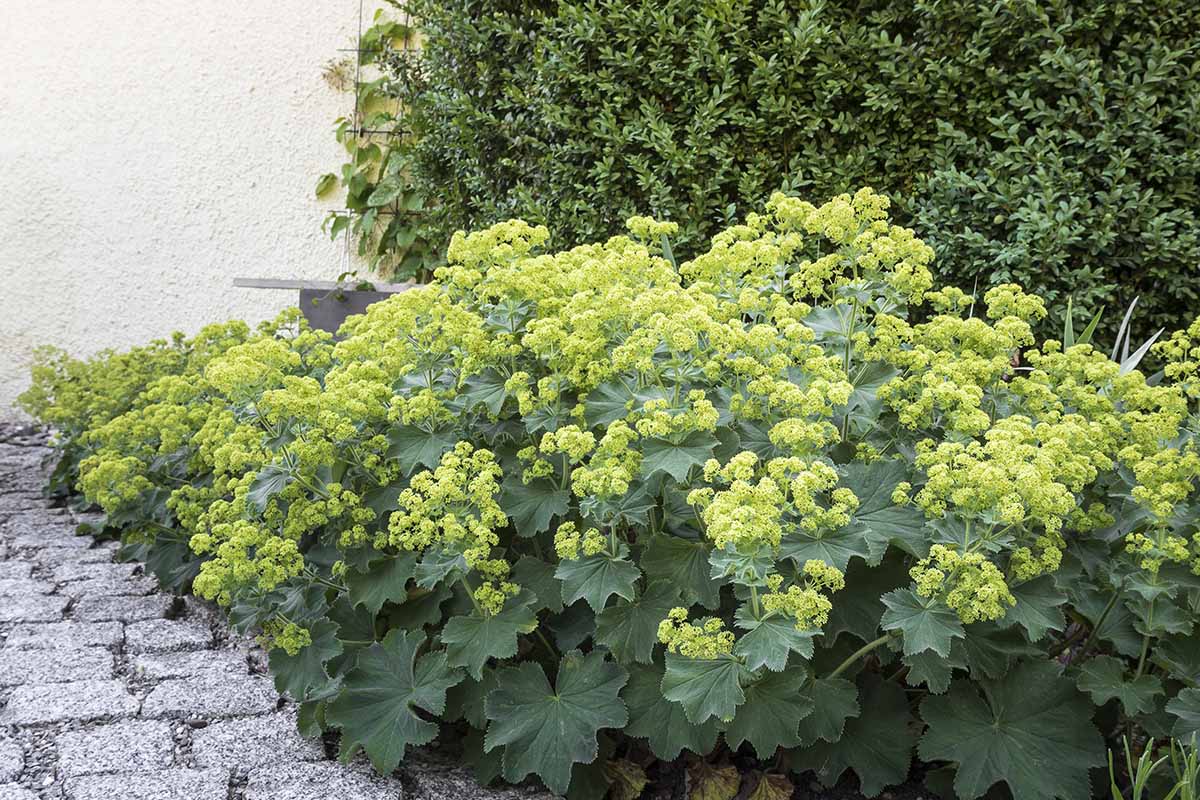
We talked before about how easy it is to grow lady’s mantle from seed, but we need to revisit that topic.
It is extremely easy for Alchemilla to grow from seed. If you’re like me and prefer to practice procrastination, Alchemilla is not for your garden.
This plant grows so quickly, readily, and aggressively from seed that it’s borderline invasive.
The best way to get ahead of this before it becomes a problem is to immediately deadhead your lady’s mantle after it finishes blooming.
Don’t even wait for the flowers to dry; as soon as they’re starting to wilt, cull them from the plant. If you let it go to seed you’re going to be scraping seedlings for the rest of the year.
You should also cut back all of the foliage after it flowers. A quick spray of new growth will pop up before you know it, and you’ll have a tidy plant for the rest of the year.
Lady’s mantle is a ridiculously hardy plant and it can handle this treatment.
In the Fall
Right before the ground starts to freeze you’re going to inspect your lady’s mantle and remove any faded or sunburnt leaves, and clean up the area around the crown.
Triple check that you’ve cut away all flower heads, and tuck your A. mollis in for a nice winter’s sleep.
By the way, tucking your plants in for the winter is a vital requirement for everything in your garden. It’s an unwritten gardener’s rule, trust me on this.
Where to Buy
Nature Hills Nursery is an excellent online resource for plants like lady’s mantle, which they have available in #1 containers. This is my go-to source for any perennials I order online.
If you prefer to do your shopping in person, most garden centers will carry Alchemilla.
Managing Pests and Disease
It’s no exaggeration at all to say lady’s mantle is almost completely pest free.
Part of the reason it’s considered invasive in certain areas is due to its adamantine resistance to critters, fungi, and other types of disease.
Once in a while slugs may munch on the foliage, but that’s about it.
The only potential disease issues you might encounter are in the far southern ranges of where lady’s mantle can be considered hardy.
In warm regions with high humidity you might encounter fungal issues and the best remedy is to clean up and destroy any gross foliage.
Alchemilla responds very well to this kind of care, so don’t be shy about hacking away any unhealthy growth whenever you see it.
If you enjoy garden chores like applying pesticides and fertilizers, you could use a fungicide spray here, but it’s really unnecessary.
I have been using Captain Jack’s lately and find it at least as effective as any other copper fungicide.

Captain Jack’s Copper Fungicide
You can buy the concentrate if you have a sprayer at home, or you can grab a pre-mixed container like this one that’s available from Bonide on Amazon.
Best Uses for Lady’s Mantle
It’s as if A. mollis was made for a few specific uses in the landscape.
Very few plants will be as happy as lady’s mantle when planted along walkways and garden paths. The frothy foliage and flowers spill over footpaths and soften hard lines very effectively.

You could also grow lady’s mantle in containers as a filler plant.
Be prepared for it to overtake the space it grows in, though, and keep your pruners or shears at the ready to keep the beast in check.
If used in a container I’d recommend growing it with plants that are narrow and upright.
If it’s a smaller container, I’d suggest something like angelonia or cleome. If you’ve got a larger container to work with, geraniums and heuchera make an awesome match.
I’d also suggest adding something that hangs and “drips” over the container’s edges.
I’ll be a devotee of Dichondra ‘Silver Falls’ until the day I die and will always recommend it in any container planting.
You could match your lady’s mantle with other great trailing plants like sweet alyssum, string of pearls, and the tried-and-true vinca vine.
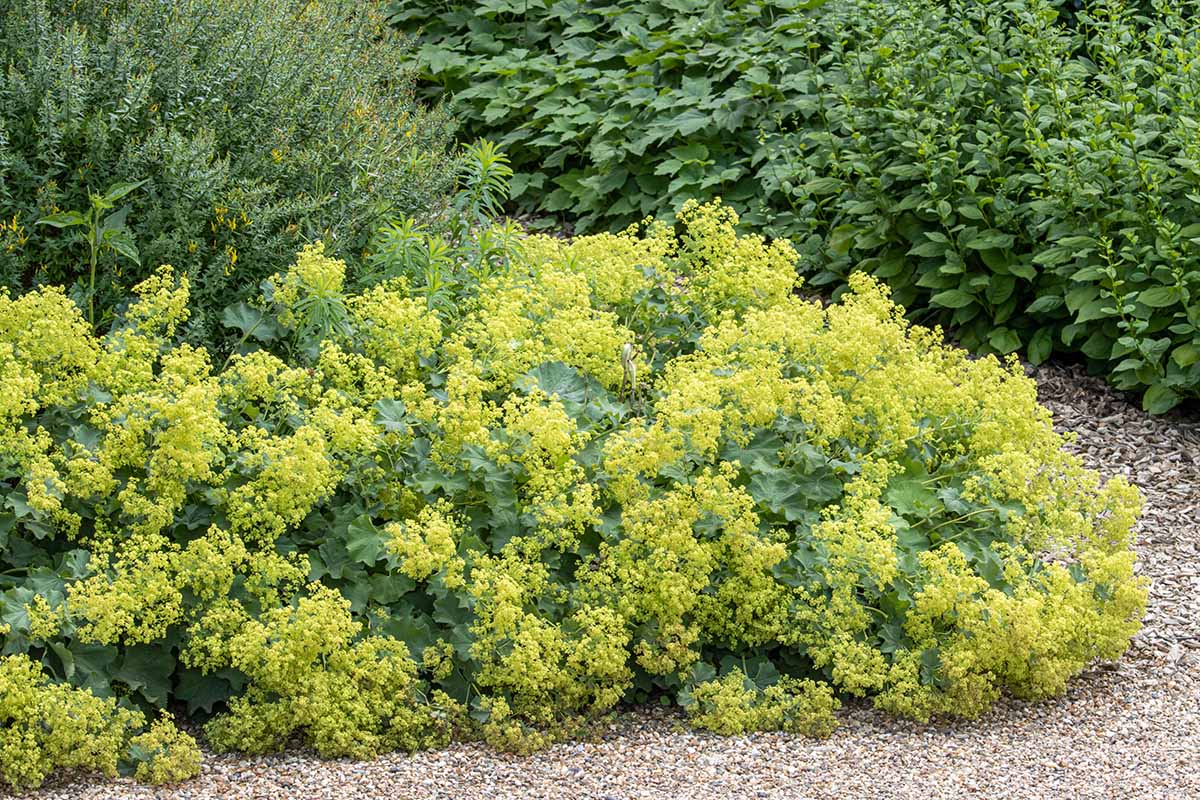
You’ll be delighted to have A. mollis in any woodland setting, especially where the plant can drink up lots of morning and early afternoon sun.
It can be a single feature in any bed, or you can (mostly) let it go to fill up a larger chunk of real estate. It does well with astilbe, heuchera, yucca, delphinium, and guara in these settings, in my experience.
Quick Reference Growing Guide
| Plant Type: | Herbaceous flowering perennial | Flower/Foliage Color: | Pink/emerald green |
| Native to: | Turkey, Carpathian Mountains | Maintenance: | Low |
| Hardiness (USDA Zones): | 3-8 | Tolerance: | Shade, drought, poor soil |
| Bloom Time: | Late spring-early summer | Soil Type: | Average, loose |
| Exposure: | Full to part sun | Soil pH: | 5.5-6.5 |
| Time to Maturity: | 2 years | Soil Drainage: | Well-draining |
| Spacing: | 12-18 inches | Attracts: | Butterflies, other pollinating insects |
| Planting Depth: | 1/4-inch (seeds), depth of root system (transplants) | Uses: | Containers, garden beds, woodland designs |
| Height: | 8-12 inches | Order: | Rosales |
| Spread: | 18-24 inches | Family: | Rosaceae |
| Water Needs: | Moderate | Genus: | Alchemilla |
| Common Pests and Disease: | Slugs, snails; fungal issues, root rot | Species: | Mollis |
A Farewell to a Fine Lady
What an easy plant to add to your garden! It’s hardy, it’s adaptable, and it’s a looker.
As long as you keep up with deadheading the plant before it goes to seed, you’ll have a full and vibrant specimen in your garden.
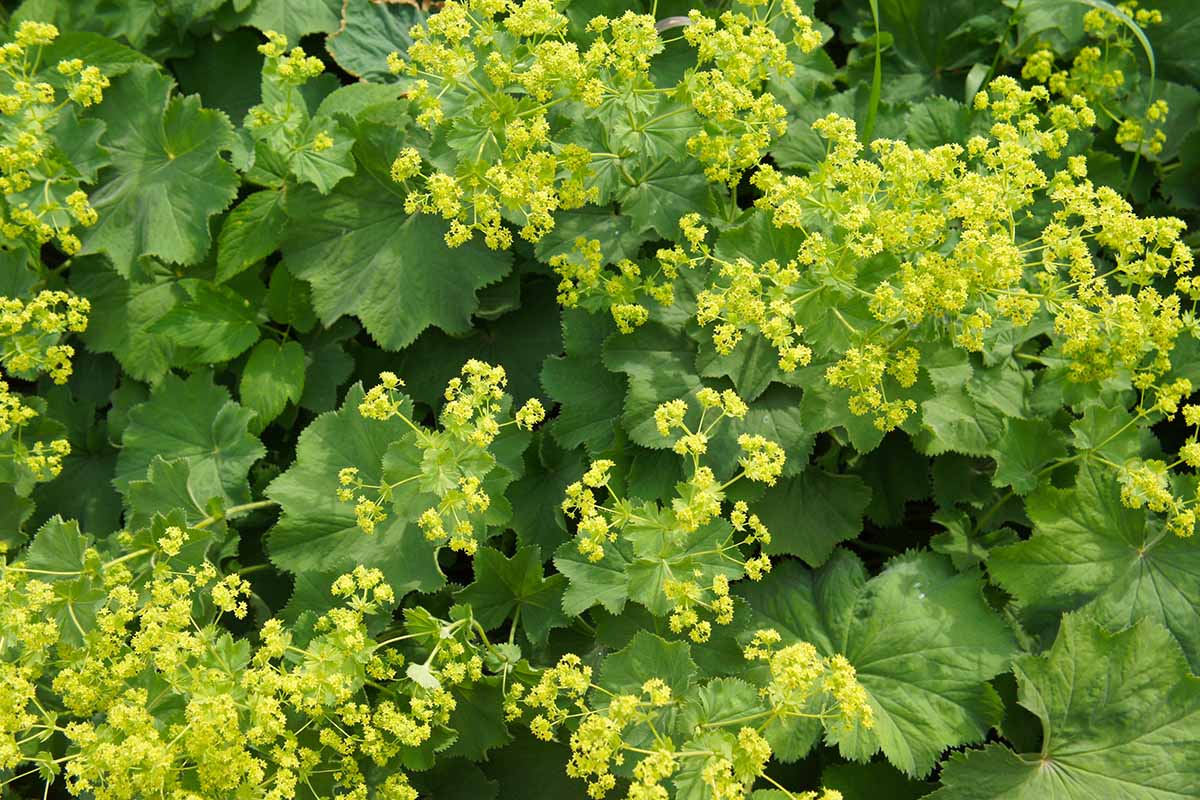
Lady’s mantle may not be a native plant, but it’s a splendid addition to any garden that has space for it.
Supposedly, the plant’s Latin name makes reference to alchemists believing drops of water that collected on the tiny hairs of Alchemilla leaves were the purest form of water attainable.
They’d use this water in their pursuits, hoping to transform lead into gold.
I can’t say if they were right or wrong. But every garden that includes lady’s mantle flaunts a few bits of gold, as far as I’m concerned.
Are you growing lady’s mantle? Let us know in the comments section below! And feel free to ask any questions that come to mind.
If you found this guide valuable (I know you did!), you might as well keep a good thing going, right? Check out some of our other flower-growing guides next:
